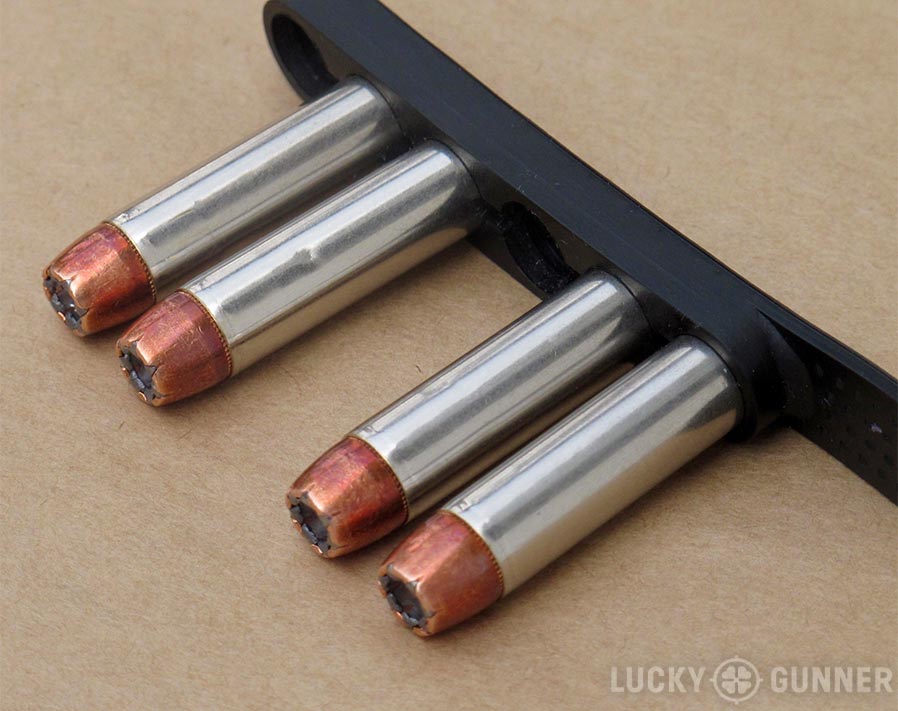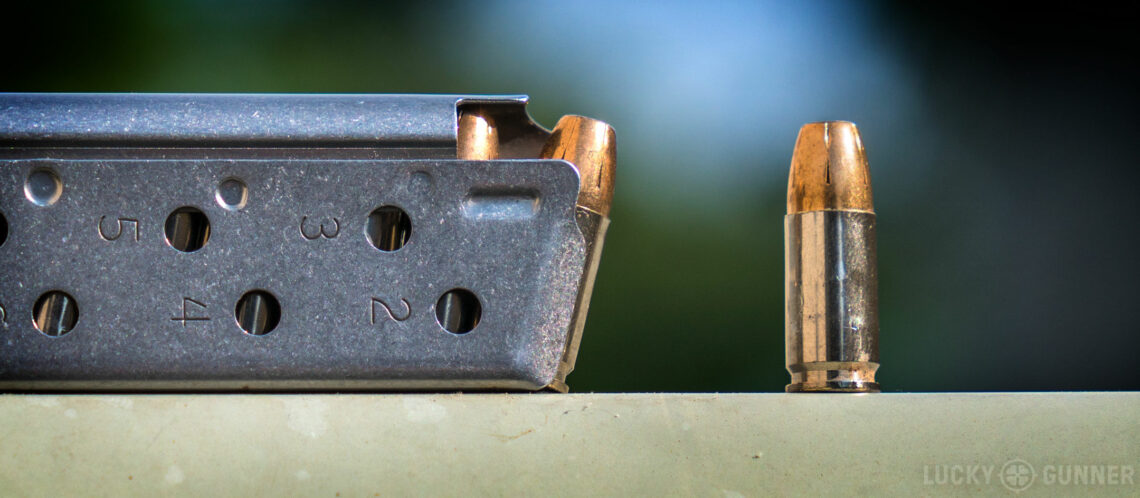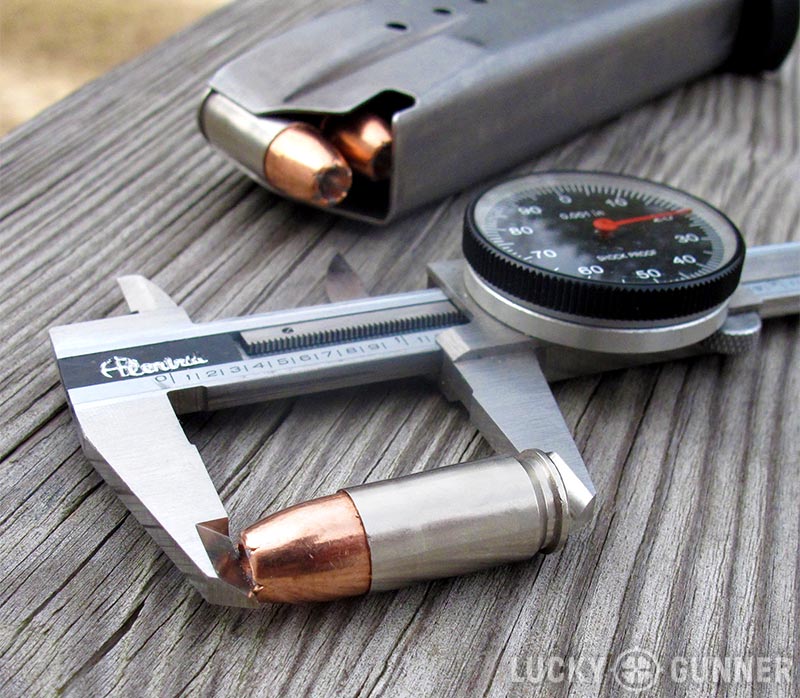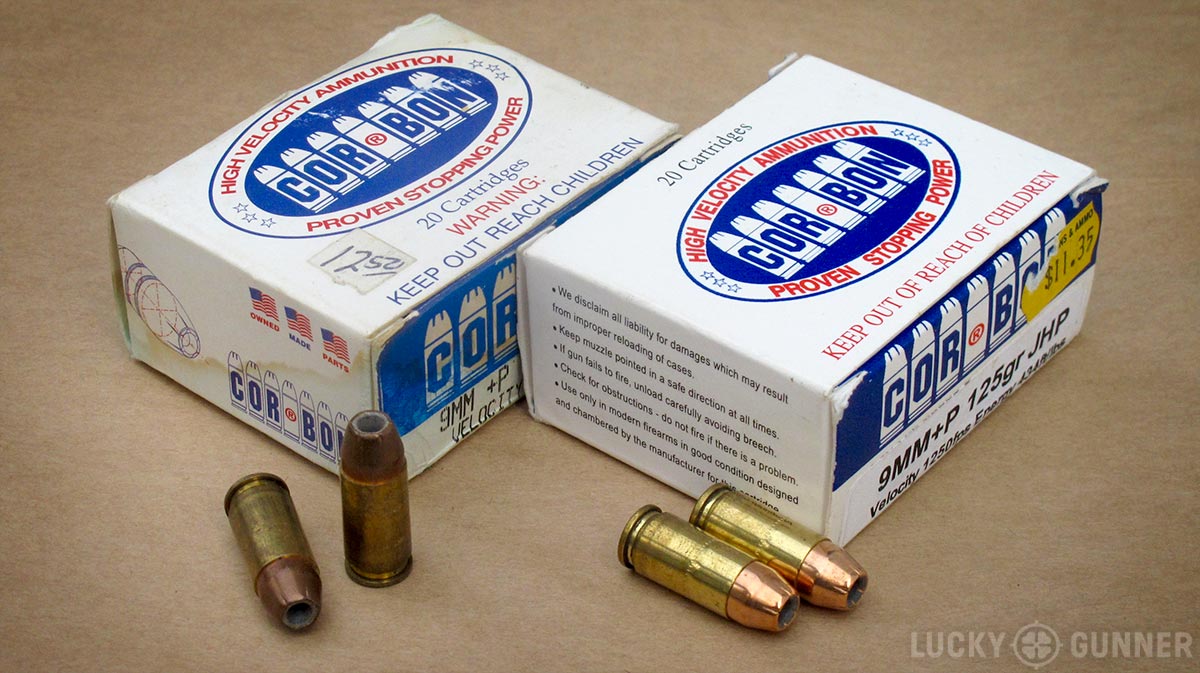A while back, Chris talked about how to choose your self-defense ammunition, and he brought up the idea of rotating self-defense ammo in carry weapons — the practice of periodically replacing the ammo loaded in your defensive firearms with new rounds. Since then, I have thought about this quite a lot and wanted to tackle the topic in a little more detail.
As he mentioned, premium self-defense ammunition is expensive and certain loads can be hard to come by. Unfortunately, it’s far from ideal to buy just enough to load up a couple of mags and call it a day. As Chris also pointed out, you should get enough to run some accuracy and reliability tests and still have plenty left over to occasionally replace the ammo after it’s been loaded for a while. So how often is often enough? How often should you replace that $20 to $30-worth of ammunition for fresh rounds?
Consider the Type of Gun
First, are you carrying a semi-auto pistol or a revolver? This might sound like an arbitrary distinction, but in an attempt to isolate every variable, we need to answer this question. With a revolver, your rounds are dropped smoothly into the chamber. Every surface of the ammunition, save the face of the bullet, is protected, and there is no high-impact insertion into the chamber. Additionally, the process of “press-checking” a revolver (swinging the cylinder open to verify its condition) imparts no additional stress on individual cartridges.
On the other hand, autoloading pistols have a tendency to beat the daylights out of the first couple of rounds in the magazine. When the gun is loaded, the first round is slammed rather violently into the chamber. The second round is subject to the slide’s movement over its case, and if you load and unload frequently, these two probably get cycled in and out of the chamber more than once.
The “revolver or auto” question also pertains to any spare ammunition you carry. With extra mags for a semi-auto, all of the ammunition in the magazine is protected by the magazine body with the exception of the first round. If, like me, you carry a revolver, things are a bit different. I carry spare rounds in a Bianchi Speed Strip in my back pocket. After a month or two, the rounds on this strip are discolored and usually one or two of the cases is at least a little dented. If you carry speedloaders in belt holders (or magazines in magazine pouches), the ammo will probably not age as quickly, but can still eventually encounter issues from exposure moisture and debris.
Consider How it is Used
The next question you should be asking is, “How do I use the gun?” Is the gun a nightstand pistol that rarely leaves the bedside table? Is it a daily carry gun? Do you load and unload it daily? Do you press-check it frequently? Your answers here may dictate how often you should rotate your ammunition. If the gun never leaves the bedside, the ammunition could probably last pretty much indefinitely. Because it is not exposed to sweat, humidity, temperature fluctuation, and daily handling, the ammunition should last much longer than ammunition in a carry gun. If you are like me and you check the condition of your firearm every time you put it into the holster, the ammunition in it can become a little worn and should be replaced more frequently.
Inspection Considerations: What To Look For
You should inspect your ammunition occasionally. When I pull the rounds out of my gun, I am looking for some specific indicators that it should be replaced. First, I’m going to look at the bullet itself. Some discoloration from handling is normal, but alterations in the shape of the bullet are not. Did it get slammed into the feed ramp and is now misshapen as a result? This is probably a good indicator that the whole cartridge has suffered some abuse, and the change in shape may impact the bullet’s performance. If the bullet is deformed, replace those rounds.
Next, you should look at the position of the bullet in the case. A condition called “bullet setback” can occur when pressure is repeatedly applied to the bullet – from chambering and rechambering – and forces it backward into the case. This can compress the powder and create dangerously high chamber pressures, and ammunition exhibiting bullet setback should not be fired under any circumstances (please note the scary bold type). Because a few 1000ths of an inch can make a difference, this inspection shouldn’t be eyeballed. Instead, use calipers. Measure the first couple of rounds in the gun for overall length. Compare this length with a measured overall length from an unhandled cartridge directly from the box. You can also compare your results with manufacturer specs online if you can find them. If the bullet is set back, replace those rounds, and do not fire them.
Next, you should inspect the case. Non-nickel plated brass cases may be discolored. Some mild discoloration isn’t reason to remove them from duty, but corrosion is. Take a look at the rounds in the photo below. I purchased both of those boxes of Cor-Bon ammo circa 2001. I would carry the ammo in the box on the right, but I wouldn’t trust the really nasty stuff on the left.
Next, I inspect for deformities, especially the kind that would prevent the round from feeding reliably. These include dents or slight bulges in the case or deformities around the case mouth. I find this to be most common with revolver cartridges carried in reloading strips. I carry these in my back pocket, so each time I sit they are liable to impact with whatever I am sitting on. If cases are badly corroded or deformed, get rid of them.
Ammunition may also experience extraordinary trauma that disqualifies it from carry suitability. On the extreme end of the spectrum, I recently ran a Speed Strip and four 135-grain Gold Dots through the washer and dryer. This wasn’t some ammo torture test, just the result of my forgetfulness in cleaning out my pockets before doing laundry. The ammo came out looking squeaky clean (and it worked just fine), but there’s no way I would trust my life to it. As a less extreme example, I’ve fallen into a creek and briefly submerged my revolver. Most high-quality ammunition is manufactured to be waterproof. If I have plenty of carry ammunition in reserve, I may change it out just to be safe, but if I’m also comfortable carrying those same rounds for a while longer. If your ammunition has experienced some extreme trauma, swap it out.
Also consider your environment, lifestyle, and your body. If you live in hot climate, carry your gun during workouts or strenuous outdoor activities, or are just sweat heavily, take note! You expose your gun and ammunition to more moisture and salt more often than someone who works in an air-conditioned office, drives home in an air-conditioned car, and then hangs out in their air-conditioned home. You might want to think about rotating your ammunition a little more often.
How Often Do I Rotate?
I reached out to several big-name ammunition manufacturers while conducting research for this article, and the only specific guidance I got was this: you should rotate your duty ammunition every six months. I think this is a great guideline, but it’s still only a guideline. If you handle your gun a lot and load/unload often, you should change your ammunition more often. If your gun is a pure home-defense tool that doesn’t get cycled that much and rarely leaves a climate-controlled environment, you can safely extend that number to a year or more.
Even though I only own revolvers these days, I rotate my self-defense ammunition every 90 days. This is because I am inherently a “gun guy” and tinker with my gun a lot. I shoot it and dry practice often which means my guns get unloaded and reloaded frequently. My guns also get cleaned regularly which means my carry ammunition is in constant contact with oil, a notoriously effective primer-killer. Do you own assessment and consider your own use-case. And, when in doubt, inspect your ammunition and see if it’s time to change it out.
Extend the Life of Your Carry Ammo
You can take steps to extend the service life of your chosen carry ammunition. The most effective measure you can take is to limit the number of times an individual round has been chambered, ejected, and re-chambered. Many concealed carriers remove their gun at the end of the day, and all of us take it off before bed. Most of us also probably unload the handgun as part of this process and reload it again in the morning. If you store your carry gun in a safe or another type of locked container, you may consider taking the gun and holster off as one, monolithic unit and leaving the magazine and chambered round in place. Then you can put the whole rig in the safe instead of unloading and storing it in pieces. This cuts down dramatically on the number of times rounds are cycled through the chambering process.

Of course, there are occasions when you will have to unload the chambered round, like when dry practicing, prepping for a range session, or getting the gun ready for longer-term storage. The best strategy here is to occasionally rotate the position of those rounds in your magazine to avoid wear on any single cartridge. If you do find yourself loading and unloading frequently, take a couple minutes once a month to unload the magazine and cycle those first few rounds to the bottom. This helps ensure that any single round doesn’t suffer an undue amount of abuse. If your gun holds 10 rounds, this simple step can reduce wear and tear on an individual cartridge by 80%. If you carry something with more capacity, you’ve just created an even greater margin for error.
What do I do with the ammunition that comes out of the rotation? I shoot it. There is some value here, other than just an expensive range session. When I change the ammunition out, I go to the range and run a “cold bore” drill. I will usually set up a drill that requires a presentation from the holster followed by a full cylinder, all on the clock. Firing in my exact carry setup – including ammunition – gives me a really good indicator that my setup is actually working for me. It also gives me confidence in my ammunition. The ammo that ran through the washer and dryer? I shot that, and it worked, which makes me very confident that a quick splash in a creek or getting caught in a downpour isn’t going to ruin my carry ammo.
I admit this does cost a little money. I fire 10 rounds every three months, totaling 40 rounds per year. This means that a 100-round supply of carry ammunition should last me roughly two and a half years. Though it hurts to see my precious supply of premium ammo go down by 10 rounds, it’s cheap insurance. For me, it’s totally worth it for the peace of mind in knowing that my ammunition will work when it has to.




Good information, thanks. 🙁
I rotate my SD ammo once a year. Too lazy and cheap for the six month cycle.
Since the kids are long grown up and gone; my carry guns only get unloaded when they’re going to the range.
I don’t rotate my carry ammo, other than the first couple of rounds in the mag, due to setback.
I’ve never yet had any “old ammo” fail to fire, and that includes some 45 acp that I reloaded back in the ’90’s, and some .22 LR that I bought back when the boys were little kids (’80’s).
I also have some old military 45 acp that was boxed in 1943 that still shoots fine.
Somewhat related; I load all my ammo to standard power levels. I don’t care for “powder puff” range loads myself, as I want my practice ammo to recoil, and shoot to the same POA = POI, as my carry ammo.
Doing otherwise has never made much sense to me.
I am with you, carry only gets unloaded if I am going to range, and it was my understanding that ammo was made to last more than a year.
Mine gets unloaded for dry fire practice too but other than that it stays ready.
As an aside, no ammo is absolutely perfect. Case in point. I recently attended a concealed weapons permit course that required 100 rounds to be fired. I’d had feeding problems in this particular gun with my reloads so I opted to purchase new ammo for the course. Less than halfway through the course of fire, I had a failure to fire. I ejected the round and the primer had a full hit on it. I took it home, dis-assembled the round and it appeared that the primer ignited but for whatever reason, the powder did not ignite. This is brand new ammo from a major manufacturer. To my knowledge, this is the only factory round, aside from 22lr that ever failed me when shooting. Just consider that the stuff we all carry is indeed exposed to all manner of things that may cause a failure to fire.
The big ammo companies churn out several million rounds every month. Even the factories with top notch QC are going to let a few defective rounds slip out the door.
I don’t understand unloading your carry gun when you get home. If your carry gun is different than your “night stand” gun, then why don’t you just lock up your carry gun before you hit the rack? No need to unload it. My carry gun stays on me until I go to bed. It gets locked up, and the night stand gun comes out. In the morning, the process is reversed.
I don’t understand it, either, but from what I read online it seems to be a thing a lot of people day. I am certainly not advocating that method for people who already have a way to store their gun that they are comfortable with and that is safe.
I notice that some hollow points I keep in speed loaders get deformed at the tips. This is especially true for the 158 grain SWCHP (38 spcl. +P). If the tips look to be “folding in”, I replace them. Copper clad hollow points are not as bad, but I have replace them on occasion when they look to be closing up. I try to shoot a box (20 rounds) “carry rounds” every 3 – 4 months, regardless of the practice rounds in between. Keeps the stuff I rely on to keep me alive fresh!
And the reason you haven’t shot up the two boxes of cor-Bon? Which by the way, have $12.50 and $11.35 prices marked on them. My, how times have changed. Good advice though, thanks.
Those boxes were packed up in my stuff “back home” from before I left for the military over 15 years ago. I just recently found them and the price tag was a little trip down memory lane. I’ll shoot them up one of these days.
I have a question I haven’t seen addressed yet. Is it ok to leave a magazine loaded for a long time. I heard both sides, does it spring get weak over time?
It’s probably okay, but since the mag spring is such a common failure point in a semi-auto pistol, it’s not a bad idea to rotate magazines every couple of years if you keep them loaded all the time. Maybe more often if you’re actually carrying the gun and it’s exposed to temperature fluctuations and dust and debris. Here are some additional thoughts on the issue: http://www.luckygunner.com/lounge/magazine-springs-and-ammo-cycling/
I’ve heard several thoughts on the mag issue. One is leave them fully loaded, another is leave the mag loaded down by one or two(especially if you’re talking rifle mags). I’ve also heard the reasoning that once loaded, leave them that way as what weakens the springs is compression and decompression.
My method, fire off the top three or four rounds in my carry pistol and the same for by spare mag. Then unload the remainder and use ball for the rest of my training. When I’m done, three or four new rounds go in the bottom of each mag. That way I slowly rotate the ammo and I also get a test that my carry setup is working for the first three or four shots, which would likely be the most critical.
I also try to buy my carry ammo on sale and then get enough that I can wait unit the next sale to buy more without feeling like I have to avoid using it.
I was a Range Officer for an Agency. I would gather all the ‘old wornout’ ammo. There was no policy for disposal so I’d keep it for my use. I used it for targets, hunting and plinking. Some of it might sit around for a year or so. I never had a round fail to go off and when hunting never had a round fail to perform as ‘new’. I have also shot German 9mm ammo from 1943 and US.45 acp from the ’50s, likewise it all worked. I just do not worry about the age of the ammo except for my reloads.
Just a few comments on ammo longevity. Like the author, I have left rounds in the pockets and retrieved the now very clean rounds from the dryer then shot those rounds and everything was fine. I had a long time period of about 12 years between when I first started shooting as a hobby and when I rediscovered shooting as a hobby. I had 500 rounds of aluminum case CCI Blazer .45 ACP stored in an ammo box in the closet. All of it shot flawlessly after 12 years in the closet. The price tag on the box nearly made me cry because it was so low.
Back in ’94 an old timer gave me an unopened spam can of 30-06 for the M1 Garand. Finally got around to opening the can and shooting it in 2010. The ammo was head stamped “43” making it 67 years old. It shot flawlessly. No comments please about corrosive ammo from the war. If you know how to clean your gun it is not a problem.
Ammo is surprisingly long-lived when stored properly, especially the low humidity environment in which I live.
For carry revolvers I rotate the ammo every 6 months. I’ll usually shoot it in steel competition or IDPA. I rotate the ammo in the bedside table revolvers once every couple of years. I shoot that in steel competition or IDPA using the bedside or carry revolver.
For auto loaders, magazines stay loaded no more than 6 months. Every round that gets chambered then unloaded goes into a bucket at the time it is unloaded. Once there is enough ammo in the bucket then that gets shot in steel competition or IDPA in either a favorite pistol or my carry pistol. I’ve had 5.56/.223 rounds fail to fire after having been chambered and ejected a couple of times and don’t want to find out the hard way if pistol ammo will suffer the same problem. It’s always a good thing to practice with your carry ammo in your carry gun.
When the 24 hour Circle K closes at 11:00 PM in my neighborhood, because the clerk does not want to die over that 30 pack of beer of the $37.43 in the register, you might just find me sleeping with my old German Police Solo holster on and a loaded Sig P228 R. You might even see that holster and a belly band with multiple guns hanging within arm’s reach while I am in the shower. Two neighbors had VERY BAD home invasion incidents. One did payroll book keeping, was tied up and robbed at gunpoint. (who steals VCRs in this day and age?) The other was far worse. He sold those really cheap Asian tools at a swap meet, and dealt in cash only. A gang of young men burst in, while he was out, repeatedly raped his wife and daughters at gunpoint, while waiting for him to come home, then robbed him, and beat him half to death. I wish I had known what was going on at the time. The cops won’t even get out of their cars after dark. I’d have loved to have laid under my truck and picked these guys off one by one. .30-06, or .308, or .300 Win Mag? Nah! 6.5mm Grendel. Eventually, when I travel, I will pull off the highway onto some little ranch access road, and dump those old JHPs into some dirt clods on a little hillside, and rotate my stock. It kinda hurts to dump $50, or $75, or $150 in JHPs, but getting shot hurts lots worse.
I’ve never understood the need for rotating your ammo in your carry gun. The reliability of every EDC gun depends partly upon the ammo, and that (the reliability) should be checked regularly by firing the ammo you use in the weapon you use. If you do this, your ammo should be “rotated” consequentially. In a semi-auto, this should be done with every magazine you carry, from top to bottom. In other words, firing every round in the magazine to ensure the spring has the strength to feed every round. Even with my EDC (Colt M1911A1) and its three eight round magazine, I’ll go through a 50 round box of ammo every month or two, depending on how often I shoot it. The only rotation I adhere to is using the oldest box first.
Of course a company that sells ammo is going to recommend you cycle through it as often as possible.
I was having this discussion with some buddies the other day, and i rotate probably every 2-3 years for house/safe guns and once a year for carry.
Today i went and shot about 50 rounds of Winchester defense ammo that was 30 years old. Manufactured for LEO contract in 1988. It looked worse than your Cor-Bon above with green tarnish on the casing and projectile and they all felt almost waxy. Every round fired fine, but I cannot comment on accuracy as I hadnt tested the ammo 30 years ago. I’d prefer not to rely on something like that in a defensive situation. But i also wouldn’t be terribly concerned about reliability.
Oh! I’ve also ran a .30-06 round through the washer and drier. Fired no problem.
wow. i have 147 gr hollow points in my nightstand gloc. the ammo is 23 years old and still works. probably time to replace though. https://uploads.disquscdn.com/images/2cbf20ec92002b2528e676d1fe1be0a9acaa9d355c5f2c1296f15d6432ecda7f.jpg https://uploads.disquscdn.com/images/e42e2d7bda0aa9c8e912d66d4604ae964099476ca858e131d38c0d9461c28a47.jpg